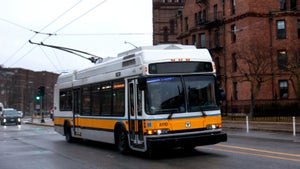Originally published at: Sweden to build road that will charge EVs while driving | Boing Boing
…
I’ve been waiting for something like this to happen. I think it’s only a matter of time before inductive chargers are being embedded in our driveways, garage floors, and public parking places. And once we have EV’s with a 1000-mile range, which is not far off, it will be game over for the ICE.
Great. Another third rail not to piss on.
What’s wrong with extension cords?
It’s a great idea, but here in the UK it would be irreparably broken within a week when the electricity / gas / water / phone / cable company came along and dug it up again.
I’m curious how Sweden is going to handle the effect of snow removal equipment on whatever system they place in or below the road’s surface. If such a project were to happen where I live in Massachusetts, the first winter with a good amount of snow likely would see such a system torn up by the plows clearing the road surface unless it was embedded a couple inches deep in the pavement.
I’d also wonder how they’d keep the circuit complete in the face of potholes (some of which are caused by the aforementioned plows) that can be large, numerous, and located right in the line of traffic.
Solar freakin roadways 2.0?
I’ve been watching such contractors do something gas-mainy out of my window all week. Yesterday, they were using a hydraulic bucket jaws thingy to scoop up rubble. Three feet away from that, they had a selection of propane cylinders, what looked alarmingly like an oxyacetylene rig, and optimistically, a fire extinguisher all stood in a row. Those lads would have had a lovely time with some buried HVDC cables added to the mix… ![]()
Solar piezoelectric near-field smart roads - then cars can charge and drive themselves!
I can’t believe people’s shock when I tell them that if electricity is not produced by 100% renewable sources then EVs do more harm to the environment than gas-fueled cars.
I’ve got a little experience with all three of those systems powering vehicles at my work and it’s really hard for me to see one of them being appropriate for trucks, buses and passenger vehicles, so it seems weird that they’re committing to the idea of a single system handling all traffic before they even figure out what that system would be.
Overhead catenary cables would be great for large vehicles and I know that’s being looked at in a number of places that have heavy big-rig traffic which mostly stays in one lane. It’s been used for certain urban bus routes for decades. But it’s very unlikely that they can come up with a practical way to connect private passenger cars to those.
I gather that the Swedish transpot administration comissioned some tests in 2018 of some kind of rail-based solution, and I’d be interested in seeing how they would adapt passenger cars to use that but can’t find much info online. I’d definitely like to know how lane changes work.
Ground based inductive charging would probably be the lowest maintenance system once installed and have the least impact on things like making lane changes, but it’s inherently less efficient than the other systems, and is most efficient when there’s a small air gap and the coils are centered. I’d be interested to see what that efficiency looks like when a vehicle is moving over a series of coils at highway speed, but can’t find that information on the site of the company that is doing development work for Sweden. The system at my work also creates some amount of heat in ferrous metals that get too close to the coils so I wonder if there would be any unintended consequences in vehicles that weren’t designed with that in mind.
Wait…didn’t I see something recently about using nuclear waste in roadways? I’m sensing a synergy opportunity. /s
If only there was a way of electrifying a transport route and make it capable of delivering large loads, quickly and efficiently between major urban areas. Maybe even put steel wheels on steel - hmmmm rails? - to reduce friction.
It was phosphate waste in Florida which unfortunately contains a small - but nasty - amount of uranium and thorium (as well as their excitingly unstable decay products).
I know. I was just making a joke.
This?


It’s proven technology.
"Hello, this is Janie Gottagun in the Channel 6 traffic copter with your traffic report on the 6’s.
We’ve got a bad accident on interstate 49, construction work making for slow going on Second Street, and you’re going to want to avoid the center of town tonight and for the next couple thousand years, as the nuclear waste used to fill in the construction on the new rotary has just started irradiating everything in a 5 mile radius."

